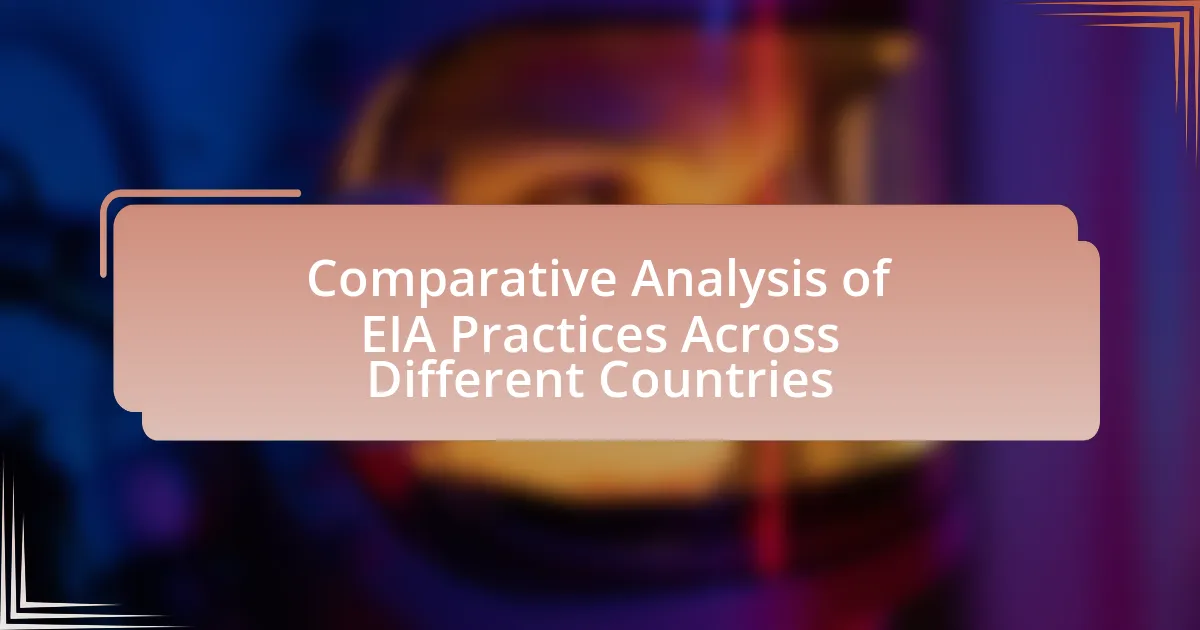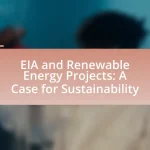The article provides a comparative analysis of Environmental Impact Assessment (EIA) practices across various countries, highlighting significant differences in regulatory frameworks, methodologies, and stakeholder engagement. It examines the importance of international comparisons in identifying best practices that enhance environmental governance and discusses the key objectives of EIAs, including the prediction and mitigation of environmental impacts. The article also explores the influence of cultural, political, and economic contexts on EIA implementation, the challenges faced by different nations, and the role of legal frameworks and capacity building in improving EIA effectiveness. Additionally, it addresses emerging trends, innovations, and practical steps for enhancing EIA processes globally.
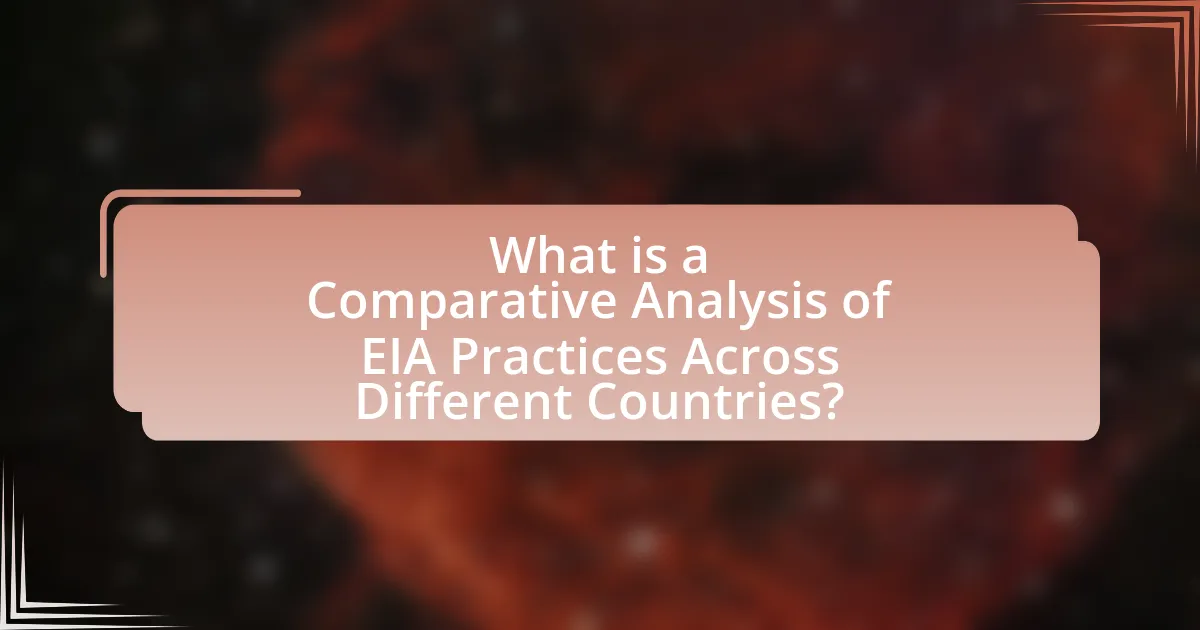
What is a Comparative Analysis of EIA Practices Across Different Countries?
A comparative analysis of Environmental Impact Assessment (EIA) practices across different countries reveals significant variations in regulatory frameworks, methodologies, and stakeholder engagement processes. For instance, the United States employs a detailed EIA process under the National Environmental Policy Act (NEPA), which mandates public participation and inter-agency collaboration, while the European Union emphasizes a more standardized approach through the EIA Directive, requiring assessments for a broader range of projects and stronger public involvement. In contrast, developing countries may have less stringent EIA regulations, often lacking comprehensive public consultation and enforcement mechanisms, as seen in some Southeast Asian nations. These differences highlight how cultural, political, and economic contexts influence EIA practices, affecting their effectiveness in mitigating environmental impacts.
Why is it important to compare EIA practices internationally?
Comparing Environmental Impact Assessment (EIA) practices internationally is important because it enables the identification of best practices and lessons learned that can enhance the effectiveness of environmental governance. By analyzing diverse EIA frameworks, countries can adopt successful strategies that improve public participation, transparency, and environmental protection. For instance, research by the International Association for Impact Assessment highlights that countries with robust EIA systems, such as Canada and Australia, demonstrate better environmental outcomes and stakeholder engagement. This comparative approach fosters collaboration and innovation, ultimately leading to more sustainable development practices globally.
What are the key objectives of Environmental Impact Assessments (EIA)?
The key objectives of Environmental Impact Assessments (EIA) are to identify, predict, evaluate, and mitigate the potential environmental impacts of proposed projects before they are carried out. EIAs aim to ensure informed decision-making by providing relevant information to stakeholders, including government agencies, project developers, and the public. Furthermore, EIAs facilitate the integration of environmental considerations into the planning and decision-making processes, promoting sustainable development. The effectiveness of EIAs is supported by various regulations and guidelines established in numerous countries, which mandate the assessment of environmental impacts for specific types of projects.
How do EIA practices influence environmental policy globally?
EIA practices influence environmental policy globally by establishing frameworks that guide decision-making processes regarding environmental impacts. These practices promote transparency and public participation, which are essential for effective policy formulation. For instance, countries that implement robust EIA processes, such as Canada and Australia, often see stronger environmental regulations and more sustainable development outcomes. Research indicates that effective EIA practices lead to improved environmental quality and compliance with international standards, as evidenced by the European Union’s EIA Directive, which mandates assessments for projects likely to have significant environmental effects. This demonstrates that EIA practices not only shape national policies but also align them with global environmental goals.
What are the main components of EIA practices?
The main components of Environmental Impact Assessment (EIA) practices include screening, scoping, impact analysis, mitigation measures, reporting, and monitoring. Screening determines whether a project requires an EIA, while scoping identifies the key issues and impacts to be assessed. Impact analysis evaluates the potential environmental effects of the proposed project, and mitigation measures outline strategies to minimize adverse impacts. Reporting involves compiling the findings into an EIA report, and monitoring ensures compliance with the proposed mitigation measures and assesses the actual impacts post-implementation. These components are essential for effective EIA practices, as they provide a structured approach to evaluating environmental consequences and informing decision-making.
What methodologies are commonly used in EIA processes?
Common methodologies used in Environmental Impact Assessment (EIA) processes include the Checklist Method, Matrix Method, Network Method, and Cost-Benefit Analysis. The Checklist Method involves a list of potential environmental impacts that must be considered, ensuring comprehensive evaluation. The Matrix Method uses a grid to assess the relationship between project activities and environmental components, facilitating a visual representation of impacts. The Network Method maps out the interconnections between various environmental factors and project activities, allowing for a more holistic understanding of potential effects. Cost-Benefit Analysis quantifies the economic implications of environmental impacts, aiding decision-making by comparing costs and benefits. These methodologies are widely recognized and utilized in EIA practices globally, as they provide structured approaches to assess and mitigate environmental impacts effectively.
How do stakeholder engagement and public participation vary in different countries?
Stakeholder engagement and public participation vary significantly across countries due to differences in legal frameworks, cultural contexts, and governance structures. For instance, in Scandinavian countries like Sweden and Norway, public participation is often mandated by law, ensuring that stakeholders have a formal role in environmental impact assessments (EIAs). In contrast, countries such as the United States emphasize a more decentralized approach, where public participation can vary widely by state and project type, often leading to inconsistencies in engagement levels. Furthermore, developing nations may face challenges such as limited resources and lower levels of civic engagement, which can hinder effective stakeholder involvement in EIAs. These variations highlight the influence of national policies and cultural attitudes towards public participation in environmental governance.
What challenges do countries face in implementing EIA practices?
Countries face several challenges in implementing Environmental Impact Assessment (EIA) practices, including inadequate regulatory frameworks, lack of technical expertise, and insufficient public participation. In many nations, the absence of comprehensive laws or guidelines hampers the effective execution of EIA processes, leading to inconsistent application and enforcement. Additionally, a shortage of trained professionals limits the ability to conduct thorough assessments, which can result in overlooked environmental impacts. Furthermore, limited engagement from local communities often leads to a lack of transparency and accountability, undermining the EIA’s effectiveness. These challenges are documented in various studies, such as the 2020 report by the United Nations Environment Programme, which highlights the need for stronger institutional capacities and stakeholder involvement in EIA practices globally.
How do legal frameworks impact the effectiveness of EIA?
Legal frameworks significantly impact the effectiveness of Environmental Impact Assessments (EIA) by establishing the regulatory requirements and procedures that govern the assessment process. Strong legal frameworks ensure that EIAs are conducted systematically, involve public participation, and incorporate scientific data, which enhances the quality and credibility of the assessments. For instance, countries with comprehensive EIA legislation, such as the United States and Canada, demonstrate higher compliance rates and more thorough evaluations compared to those with weaker or poorly enforced regulations. Research indicates that effective legal frameworks lead to better environmental outcomes, as seen in the European Union, where stringent EIA directives have resulted in improved project planning and reduced environmental degradation.
What role does capacity building play in improving EIA practices?
Capacity building plays a crucial role in improving Environmental Impact Assessment (EIA) practices by enhancing the skills, knowledge, and resources of stakeholders involved in the EIA process. This improvement leads to more effective assessments, better decision-making, and increased compliance with environmental regulations. For instance, training programs and workshops can equip practitioners with the latest methodologies and technologies, resulting in more accurate predictions of environmental impacts. Research indicates that countries with robust capacity-building initiatives, such as those implemented in Canada and Australia, demonstrate higher quality EIA outcomes, as evidenced by improved stakeholder engagement and more comprehensive assessments.
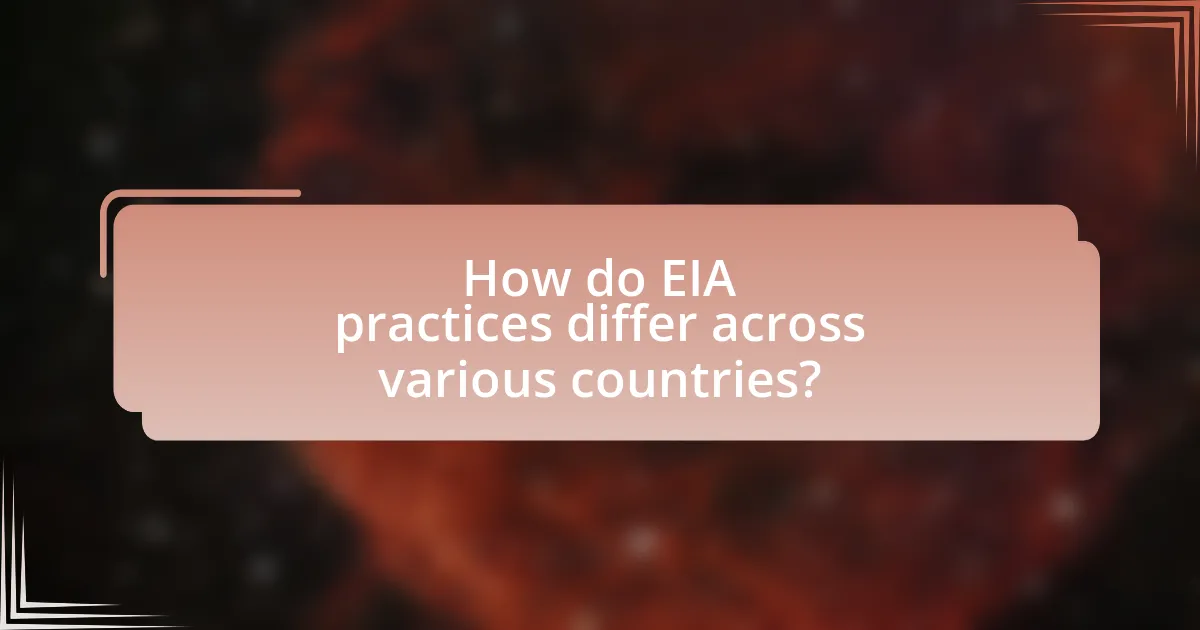
How do EIA practices differ across various countries?
EIA practices differ significantly across various countries due to variations in regulatory frameworks, cultural contexts, and levels of public participation. For instance, in the United States, the National Environmental Policy Act mandates comprehensive assessments for federal projects, emphasizing public involvement and interagency coordination. In contrast, the European Union has established a directive that requires member states to implement EIA processes that include transboundary impacts, reflecting a more collaborative approach among nations. Additionally, countries like Brazil incorporate indigenous rights and environmental justice into their EIA processes, showcasing a unique cultural perspective. These differences highlight how local laws, societal values, and environmental priorities shape the implementation and effectiveness of EIA practices globally.
What are the notable differences in EIA regulations among countries?
Notable differences in Environmental Impact Assessment (EIA) regulations among countries include variations in procedural requirements, public participation levels, and the scope of assessments. For instance, the United States mandates a detailed EIA process under the National Environmental Policy Act (NEPA), which requires federal agencies to assess environmental impacts and consider alternatives, while countries like Canada have a more integrated approach that combines federal and provincial assessments. Additionally, some European countries emphasize public participation more heavily, requiring public consultations at multiple stages, whereas other nations may have minimal public engagement. These differences reflect diverse legal frameworks, cultural values, and environmental priorities, influencing how environmental impacts are evaluated and managed globally.
How do developed and developing countries approach EIA differently?
Developed and developing countries approach Environmental Impact Assessment (EIA) differently primarily in terms of regulatory frameworks, resources, and stakeholder engagement. Developed countries typically have more comprehensive and stringent EIA regulations, supported by established legal frameworks and greater financial resources for implementation. For example, the European Union mandates detailed EIA processes under the EIA Directive, requiring public participation and thorough assessments of environmental impacts. In contrast, developing countries often face challenges such as limited regulatory capacity, insufficient funding, and weaker enforcement mechanisms, which can lead to less rigorous EIA practices. A study by the World Bank in 2020 highlighted that many developing nations struggle with inadequate institutional frameworks, resulting in inconsistent application of EIA processes. This disparity affects the effectiveness of environmental protection measures in both contexts.
What examples illustrate successful EIA practices in specific countries?
Successful Environmental Impact Assessment (EIA) practices can be illustrated by examples from countries such as Canada, Australia, and Norway. In Canada, the Canadian Environmental Assessment Agency has implemented a comprehensive framework that integrates public participation and Indigenous consultation, leading to improved project outcomes and community trust. Australia’s EIA process, particularly in New South Wales, emphasizes rigorous assessment and stakeholder engagement, resulting in effective management of environmental risks in major infrastructure projects. Norway’s EIA practices are notable for their strong legal framework and emphasis on sustainability, which have led to successful integration of environmental considerations in oil and gas projects, ensuring compliance with strict environmental standards. These examples demonstrate how effective EIA practices can enhance environmental protection and stakeholder involvement in various national contexts.
What factors contribute to the variation in EIA practices?
Variation in Environmental Impact Assessment (EIA) practices is influenced by factors such as regulatory frameworks, cultural contexts, economic conditions, and institutional capacities. Regulatory frameworks differ significantly across countries, with some having stringent EIA laws while others may lack comprehensive regulations, leading to inconsistencies in practice. Cultural contexts also play a role; societies with strong environmental advocacy may implement more rigorous assessments compared to those where economic development is prioritized. Economic conditions affect the resources available for conducting EIAs, with wealthier nations typically having more sophisticated processes. Lastly, institutional capacities, including the expertise and training of personnel involved in EIAs, vary widely, impacting the quality and thoroughness of assessments. These factors collectively contribute to the diverse landscape of EIA practices globally.
How do cultural, economic, and political contexts influence EIA implementation?
Cultural, economic, and political contexts significantly influence Environmental Impact Assessment (EIA) implementation by shaping the regulatory frameworks, stakeholder engagement, and resource allocation. Cultural values determine public perception and acceptance of environmental policies, affecting community involvement in the EIA process. For instance, in countries with strong environmental movements, such as Sweden, public participation is prioritized, leading to more rigorous assessments. Economically, the availability of financial resources impacts the thoroughness of EIAs; wealthier nations can afford comprehensive studies, while developing countries may rely on simplified assessments due to budget constraints. Politically, the strength of governance and regulatory institutions dictates the enforcement of EIA laws; in nations with weak governance, such as some in Africa, EIAs may be poorly implemented or ignored altogether, leading to environmental degradation. These contexts collectively shape how effectively EIAs are conducted and adhered to across different countries.
What impact does international cooperation have on EIA practices?
International cooperation enhances Environmental Impact Assessment (EIA) practices by promoting the sharing of best practices, methodologies, and regulatory frameworks among countries. This collaboration leads to improved standards and consistency in EIA processes, as evidenced by initiatives such as the United Nations Environment Programme (UNEP), which facilitates knowledge exchange and capacity building among nations. Furthermore, international agreements, like the Convention on Biological Diversity, encourage countries to align their EIA practices with global environmental goals, resulting in more comprehensive assessments that consider transboundary impacts. Such cooperation ultimately strengthens the effectiveness and credibility of EIA practices worldwide.
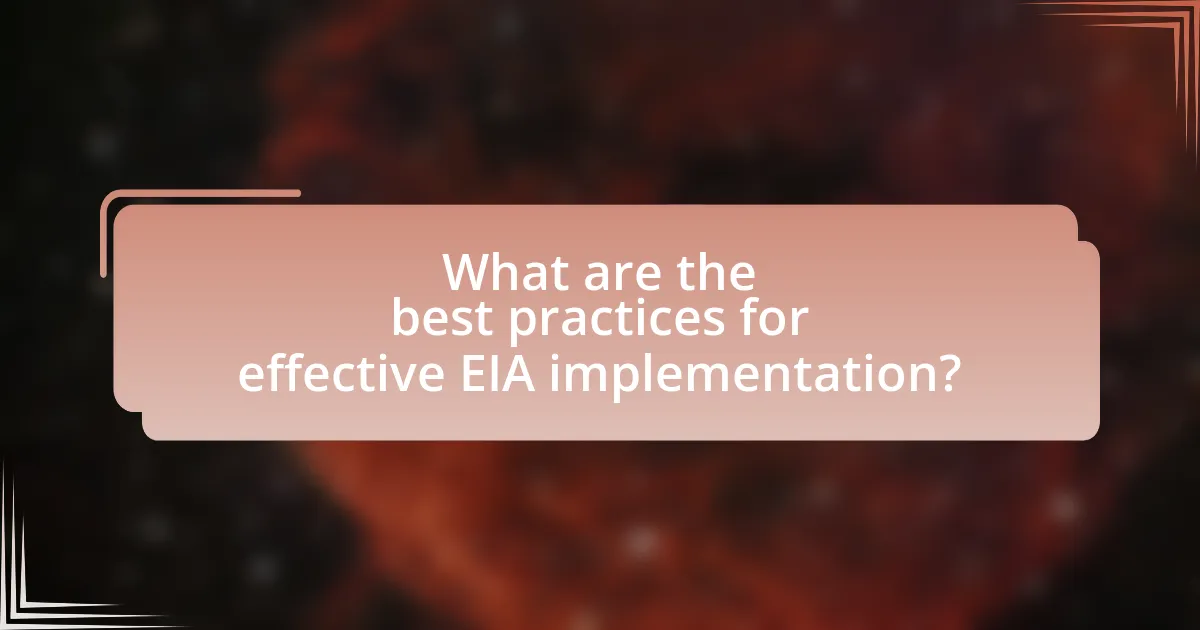
What are the best practices for effective EIA implementation?
The best practices for effective Environmental Impact Assessment (EIA) implementation include early stakeholder engagement, comprehensive baseline studies, and transparent reporting. Early stakeholder engagement ensures that all relevant parties, including local communities and experts, are involved from the outset, which enhances the quality and acceptance of the EIA process. Comprehensive baseline studies provide a thorough understanding of the existing environmental conditions, which is crucial for assessing potential impacts accurately. Transparent reporting of findings and decision-making processes fosters trust and accountability, allowing stakeholders to understand the rationale behind decisions. These practices are supported by various international guidelines, such as the International Association for Impact Assessment’s principles, which emphasize the importance of inclusivity and transparency in EIA processes.
How can countries improve their EIA processes?
Countries can improve their Environmental Impact Assessment (EIA) processes by enhancing stakeholder engagement and integrating scientific data into decision-making. Effective stakeholder engagement ensures that diverse perspectives are considered, leading to more comprehensive assessments. For instance, the European Union mandates public participation in EIA processes, which has been shown to increase transparency and accountability. Additionally, utilizing robust scientific data and methodologies can lead to more accurate predictions of environmental impacts. Research indicates that countries employing advanced modeling techniques in their EIAs, such as those used in Canada, achieve better environmental outcomes. These improvements can lead to more informed decisions and ultimately better environmental protection.
What role does technology play in enhancing EIA effectiveness?
Technology significantly enhances Environmental Impact Assessment (EIA) effectiveness by improving data collection, analysis, and stakeholder engagement. Advanced tools such as Geographic Information Systems (GIS) allow for precise mapping and spatial analysis of environmental impacts, facilitating better decision-making. Additionally, remote sensing technologies provide real-time data on environmental conditions, which can be crucial for assessing potential impacts. A study by the World Bank in 2020 highlighted that countries utilizing digital platforms for EIA processes reported a 30% increase in stakeholder participation and a reduction in assessment time by up to 25%. These advancements demonstrate that technology not only streamlines EIA procedures but also fosters transparency and inclusivity in environmental governance.
How can lessons learned from other countries be applied to improve local EIA practices?
Lessons learned from other countries can be applied to improve local Environmental Impact Assessment (EIA) practices by adopting best practices, regulatory frameworks, and stakeholder engagement strategies that have proven effective elsewhere. For instance, countries like Canada and Australia have established comprehensive guidelines that emphasize public participation and transparency in the EIA process, which can enhance local practices by fostering community trust and ensuring diverse input. Additionally, the integration of advanced technologies, such as Geographic Information Systems (GIS) used in the United States, can improve data accuracy and analysis in local EIAs. Evidence from the European Union shows that countries with robust EIA frameworks experience better environmental outcomes, indicating that adopting similar structured approaches can lead to improved local EIA effectiveness.
What are the future trends in EIA practices globally?
Future trends in Environmental Impact Assessment (EIA) practices globally include increased integration of digital technologies, enhanced stakeholder engagement, and a stronger focus on sustainability and climate resilience. The adoption of artificial intelligence and data analytics is streamlining the assessment process, allowing for more accurate predictions of environmental impacts. Additionally, regulatory frameworks are evolving to require more comprehensive public participation, ensuring that diverse community voices are heard in decision-making. A notable shift towards incorporating climate change considerations into EIA processes is evident, as countries recognize the need to address environmental challenges proactively. These trends are supported by international agreements, such as the Paris Agreement, which emphasize the importance of sustainable development and environmental protection in project planning.
How is climate change influencing the evolution of EIA practices?
Climate change is significantly influencing the evolution of Environmental Impact Assessment (EIA) practices by necessitating the integration of climate resilience and adaptation strategies into assessments. As countries face increasing climate-related risks, EIA frameworks are adapting to include comprehensive evaluations of potential climate impacts on projects and the environment. For instance, the European Union’s EIA Directive has been revised to emphasize the consideration of climate change effects, requiring assessments to address how projects may exacerbate climate vulnerabilities. This shift reflects a growing recognition that traditional EIA practices must evolve to incorporate climate science and projections, ensuring that development projects are sustainable and resilient in the face of climate change.
What innovations are emerging in the field of EIA?
Innovations emerging in the field of Environmental Impact Assessment (EIA) include the integration of advanced technologies such as Geographic Information Systems (GIS), remote sensing, and artificial intelligence (AI). These technologies enhance data collection, analysis, and visualization, allowing for more accurate assessments of environmental impacts. For instance, GIS enables spatial analysis of environmental data, while AI can predict potential impacts based on historical data patterns. Additionally, stakeholder engagement platforms are evolving, utilizing digital tools to facilitate real-time feedback and collaboration among communities, which improves transparency and inclusivity in the EIA process. These innovations are supported by studies indicating that technology-driven EIAs can lead to more informed decision-making and better environmental outcomes.
What practical steps can be taken to enhance EIA effectiveness?
To enhance Environmental Impact Assessment (EIA) effectiveness, implementing stakeholder engagement throughout the EIA process is crucial. Engaging stakeholders, including local communities, government agencies, and NGOs, ensures diverse perspectives are considered, leading to more comprehensive assessments. Research indicates that effective stakeholder participation can improve the quality of decision-making and increase public trust in the EIA process, as demonstrated in case studies from countries like Canada and Australia, where inclusive practices have led to better environmental outcomes. Additionally, integrating adaptive management strategies allows for ongoing monitoring and adjustments based on new information, further strengthening EIA effectiveness.
